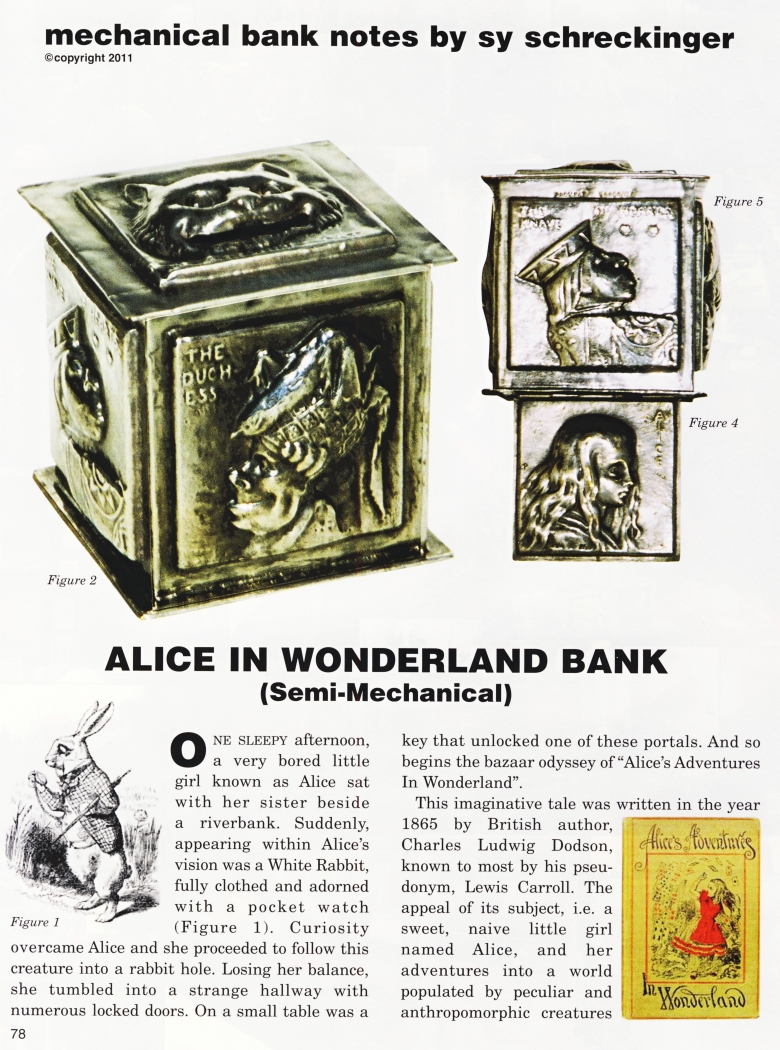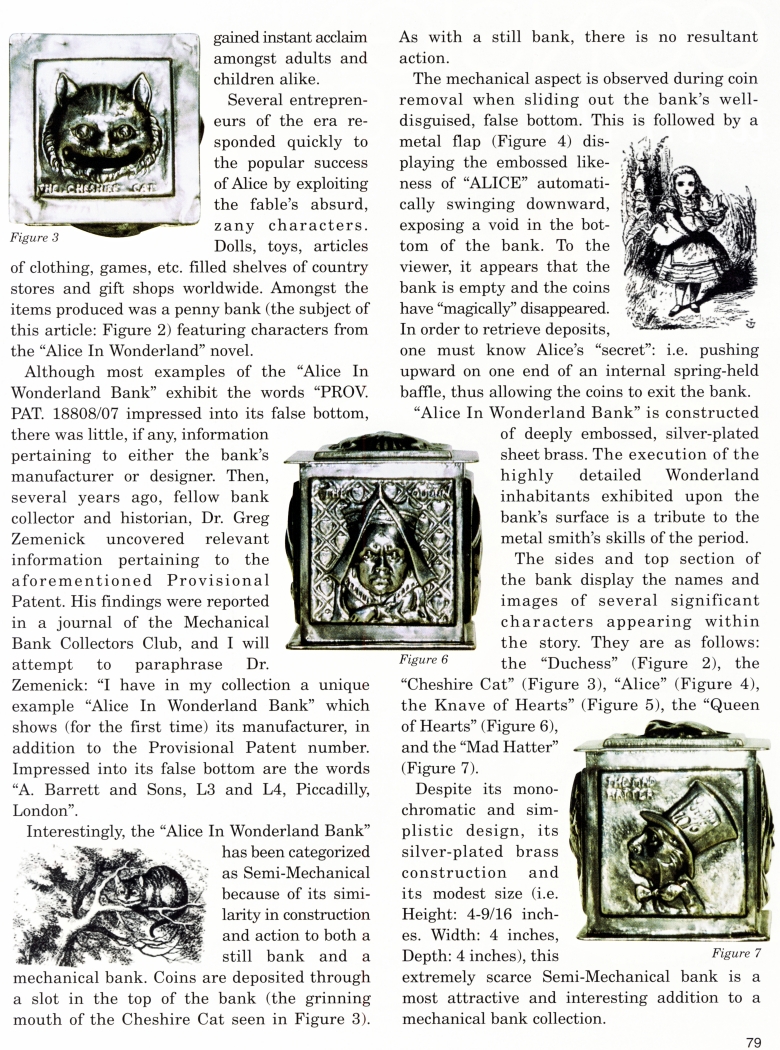|
Alice in Wonderland Bank
(Semi-Mechanical)
by Sy Schreckinger – ANTIQUE TOY WORLD Magazine – June, 2011
ONE SLEEPY
afternoon,
a very bored little
girl known as Alice sat
with her sister beside
a riverbank. Suddenly,
appearing within Alice's
vision was a White Rabbit,
fully clothed and adorned
Figure with a pocket watch
(Figure 1). Curiosity overcame Alice and she proceeded to follow this
creature into a rabbit hole. Losing her balance, she tumbled into a
strange hallway with numerous locked doors. On a small table was a
key that unlocked one of these portals. And so begins the bazaar odyssey
of "Alice's Adventures In Wonderland".
This imaginative tale was written in the year 1865 by British author,
Charles Ludwig Dodson, known to most by his pseudonym, Lewis Carroll.
The appeal of its subject, i.e. a sweet, naive little girl named Alice,
and her adventures into a world populated by peculiar and
anthropomorphic creatures
gained instant acclaim amongst adults and children alike.
Several entrepreneurs of the era responded quickly to the popular
success of Alice by exploiting the fable's absurd, zany characters.
Dolls, toys, articles of clothing, games, etc. filled shelves of country
stores and gift shops worldwide. Amongst the items produced was a penny
bank (the subject of this article: Figure 2) featuring characters from
the "Alice In Wonderland" novel.
Although most examples of the "Alice Wonderland Bank" exhibit the words
"PEW. PAT. 18808/07 impressed into its false bottom, there was little,
if any, information pertaining to either the bank's manufacturer or
designer. Then several years ago, fellow bank collector and historian
Dr. Greg
Zemenick uncovered relevant information pertaining to the aforementioned Provisional the bank
Patent. His findings were reported
in a journal of the Mechanical Bank Collectors Club, and I will
attempt to paraphrase Dr.
Zemenick: "I have in my collection a unique example "Alice In Wonderland
Bank" which shows (for the first time) its manufacturer, in addition to
the Provisional Patent number. Impressed into its false bottom are the
words "A. Barrett and Sons, L3 and L4, Piccadilly, London".
Interestingly, the "Alice In Wonderland Bank" has been categorized as
Semi-Mechanical because of its similarity in construction
and action to both a
still bank and a
mechanical bank. Coins are deposited through
a slot in the top of the bank (the grinning
mouth of the Cheshire Cat seen in Figure 3).
As with a still bank, there is no resultant action.
The mechanical aspect is observed during coin removal when sliding out
the bank's well-disguised, false bottom. This is followed by a metal
flap (Figure 4) displaying the embossed likeness of "ALICE" automatically swinging
downward, exposing a void in the bottom of the bank. To the viewer,
it appears that the bank is empty and the coins have "magically"
disappeared. In order to retrieve deposits,
one must know Alice's "secret": i.e. pushing upward on one end
of an internal spring-held baffle, thus allowing the coins to exit the
bank.
"Alice In Wonderland Bank" is constructed of deeply
embossed, silver-plated sheet brass. The execution of the
highly detailed Wonderland inhabitants exhibited upon the bank's
surface is a tribute to the bank's surface is a tribute to the metal
smith's skills of the period.
The sides and top section of
aforementioned Provisional the bank display the names and
images of significant characters appearing within the story. They are as
follows: the "Duchess" (Figure 2), the "Cheshire Cat" (Figure 3), "Alice" (Figure
4), the Knave of Hearts" (Figure 5), the "Queen of Hearts" (Figure 6),
and the "Mad Hatter" (Figure 7).
Despite its monochromatic and simplistic design, its silver-plated brass
construction and its modest size (i.e. Height: 4-9/16 inches. Width: 4
inches, Depth: 4 inches), this Figure 7 extremely scarce Semi-Mechanical
bank is a most attractive and interesting addition to a mechanical bank
collection.
|


